Formulation effects on the thermomechanical properties and permeability of free films and coating films
Pharmaceutical Technology Europe
Understanding a formulation's variable effects on its properties, especially film permeability, is key to designing a robust formulation and reducing variation of a finished product.
Understanding a formulation’s variable effects on its properties, especially film permeability, is key to designing a robust formulation and reducing variation of a finished product. The effects of plasticizer (polyethylene glycol 3350) and water on film properties were investigated, with a particular focus on how a small change in acetyl content in cellulose acetate polymer affects the permeability of the coating films. Results show that an increased level of plasticizer leads to a decrease in free film mechanical strength and an increase in permeability.
Cellulose acetate (CA) is a polymeric excipient widely used in pharmaceutical dosage forms for controlled release15 and taste masking; 68 it is also one of the most suitable materials to serve as a semi-permeable membrane for osmotic drug delivery systems.9,10
Although osmotic drug delivery systems have many designs and configurations, they generally consist of a tablet core surrounded by a semi-permeable membrane.11 Many factors could affect the release rate of an active needed to be delivered and, thus, the selection and design of the semi-permeable membrane remain one of the great challenges for formulation scientists.
Knowing the relationship between a formulation and its film properties is crucial for designing a membrane to control release rate. When investigating the effects of solvent systems (acetone and acetone/water), polyethylene glycol (PEG) molecular weight and level on the properties of CA‑free films, Yuang, Shang and Wu found that water as a co-solvent in the formulation definitely affected morphology and, ultimately, the properties of the films.12 The films prepared from acetone were transparent, flexible and stronger, but less permeable to water vapor compared with films containing water as a co-solvent. Similar results were published by Meier et al. when they studied the influence of the plasticizer content and film preparation procedure on the morphology, thermal and mechanical properties of CA films plasticized with poly(caprolactone triol) (PCL-T);13 they demonstrated that the addition of water, a non-solvent, during the membrane-casting process was a simple and effective way to change membrane porosity and, consequently, the drug‑permeation profile. When small quantities of non-solvent were used to obtain low-porosity membranes, the presence of a plasticizer agent could be used to better modulate drug permeation.14
In general, as the acetyl content in CA increases, the CA film permeability decreases, solvent resistance increases and the glass transition temperature increases.15 However, for the small variation within the specification of CA‑398‑10NF‑EP, no study has been found to address the effect of the acetyl content on CA film properties. Although free film properties would provide insight for predicting permeability of the films, applying CA polymer onto a substrate is a final step to ensure the release profile as designed. The objectives of this study were to investigate the acetyl content in CA polymer on the film properties, particularly the permeability of free films and coating films, and to study the effects of plasticizer level (polyethylene glycol 3350) and water level on the properties of free films and coating films.11
Materials and methods
Materials
CA‑398‑10NF‑EP with acetyl content at 39.4% and CA‑398‑10TG (technical grade) with acetyl content at 40.3% (Eastman Chemical Company, TN, USA) were used in the study, and the plasticizer (Pz) investigated was polyethylene glycol 3350 (PEG 3350, Sigma Aldrich, MO, USA). High-purity acetone (B&J Brand, Burdick & Jackson, MI, USA) and deionized water (NANOpure water system; Barnstead, CA, USA) were used as the solvent system. When applying CA onto tablets, the coating formulations were the same as those casting films while the tablets to be coated consisted of 98.5% of POLYOX water-soluble resins with an MW of 5 000 000 (Dow Chemical, MI, USA), 0.5% of colourant (Sensient Technologies Corp., MO, USA) and 1.0% of magnesium stearate (Mallinckrodt Baker Inc., NJ, USA). All of these materials were used as received.
Preparation of CA free films
The CA‑free films were prepared using a solvent evaporation method. PEG 3350 was dissolved in water for 1.5 h and then most of the needed acetone was added to the solution. CA was gradually added under stirring, after which stirring continued for another 2 h to allow the CA to dissolve completely. The remaining needed acetone was added to the above mixture, followed by stirring for 30 min. After the CA solution was degassed for approximately 3 h, the solution was ready to be used to cast films (the film‑cast method and procedures can be found in reference 12). The film formulations were developed based on an experiment design; the design space was that water varied from 0.0–10.0% and the ratio of Pz to polymer varied from 0.00 to 0.29. There were three repeated points (centre point) for CA‑398‑10NF‑EP and one centre point for CA‑398‑10TG, and the design was constrained with water, which must be in the formulation whenever Pz is present. Table 1 lists all of the free films prepared.

Characterization of CA free films
The prepared films were characterized and film properties such as film morphology, glass transition temperature, oxidative and thermal stability, mechanical strength and elongation, contact angle and water vapour transmission rate were determined according to the methods described in a previous article.12
Preparation of model tablets
POLYOX (MW of 5 000 000), blue dye and magnesium stearate were blended in a V‑blender (The Patterson Kelly Co. Inc, PA, USA) for 3 min with the intensifying bar on for 15 s. The above mixture was then compressed into 250.0‑mg tablets on a rotary tablet press (D3B 16 station; Manesty, UK) under 200‑lb compression force.
CA coated on the model tablets
The CA coating formulations at 6.0% solid level were prepared following the same procedures used to prepare CA free film, except there was no degas step. Table 2 lists the coating formulations having four repeat points (centre point) for CA‑398‑10NF‑EP and one centre point for CA‑398‑10TG based on the same experimental design as the free films.
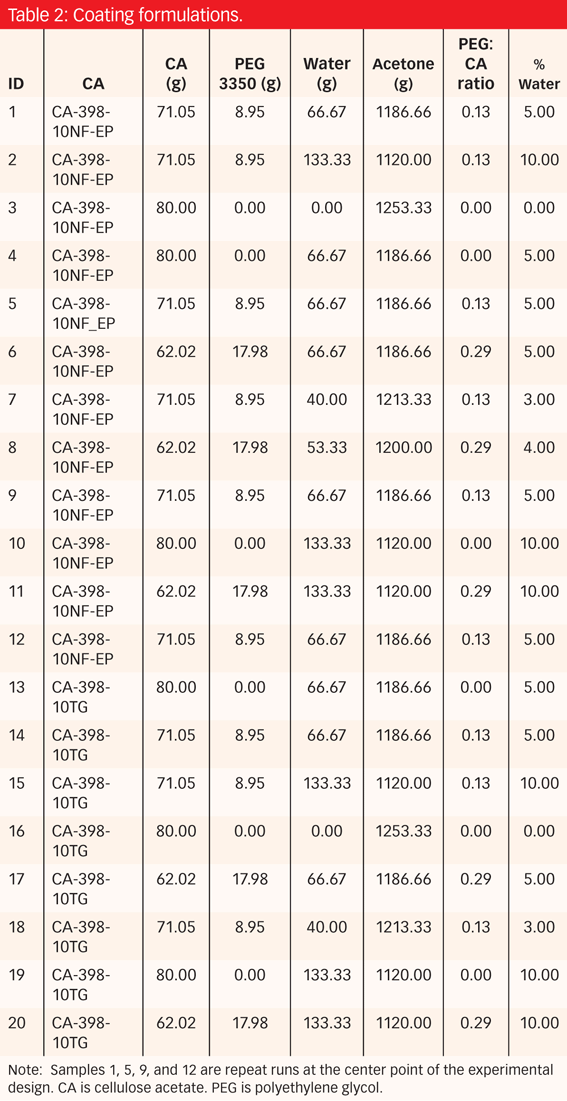
All of the coating runs, with a target coating weight at 10.0 wt% relative to the tablet weight, were performed in a pan coater (COMPU‑LAB; Thomas Engineering, Inc., IL, USA) with one spray gun under the processing conditions indicated in Table 3. For each run, 800.0 g of tablets were coated and all coating runs were repeated at least twice.
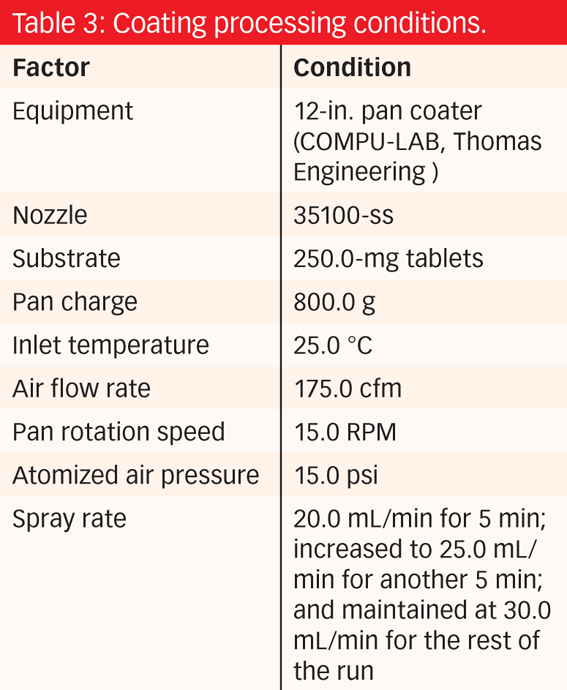
Testing of CA coated tablets
Eight tablets from each coating run were randomly selected and tested in deionized water at 37 °C to determine water uptake using a standard disintegration tester. At selected time intervals, the tested tablets were taken out, gently dried with a tissue and weighed. The water uptake was calculated using the following equation:

Results and discussion
Effects of plasticizer and water level on CA free film propertiesThe CA free films were opaque, except for the two films that did not include water in the formulation, which were transparent. Previous studies concluded that water in the film formulation affects the morphology of the film.13,16 Film properties results are organized in Tables 46 according to the water content in the formulations.
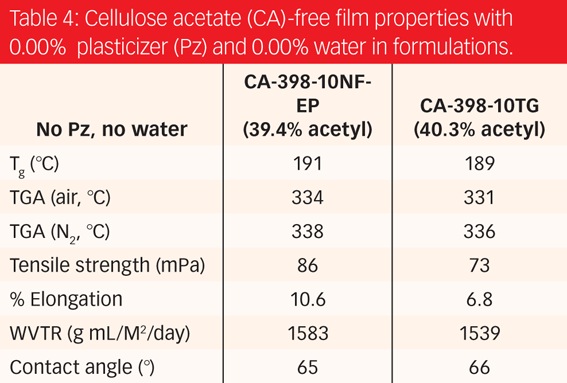
Modulated differential scanning calorimetry data show that glass‑transition temperature (Tg) changed from 191 °C without the Pz and water in the formulation to 185 °C, with the most Pz and the highest water level in the studied range. The small change suggests that PEG 3350 is not a very effective plasticizer for CA films in the studied range, which is consistent with the result of a previous study.12

The value of T10 (°C, N2 purge), at which temperature 10% of the sample weight is lost, represents the thermal stability of the films. The value of T10 (°C, air purge) represents the oxidative stability of the films. Thermogravimetric analysis (TGA) results indicated that the Pz and water level did not have significant influence on the thermal and oxidative stability of the films because the temperatures did not vary greatly with increasing Pz and water level.

Figure 1 shows the mechanical strength of the CA free films as it varies with water and Pz level; PEG 3350 and water level influence mechanical strength significantly, with PEG 3350 level having the major effect.
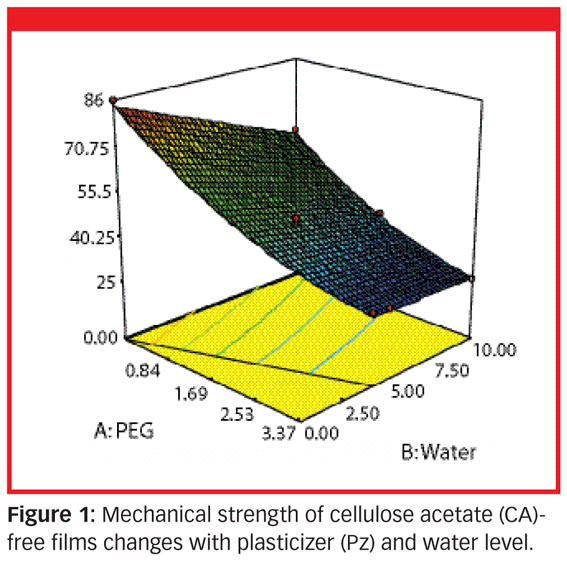
With increasing PEG level, the films weakened, which was expected because a plasticizer increases polymer chain mobility and decreases mechanical strength. Water functions as a weak plasticizer so that the film mechanical strength decreased with increasing amount of water in the formulations. The significant mechanical strength decrease may also be contributed to by the morphology of the films. Figures 25 show the scanning electron microscope images of the CA free films. With increasing Pz level and water level in the formulations, the number and size of the pinholes increased significantly.
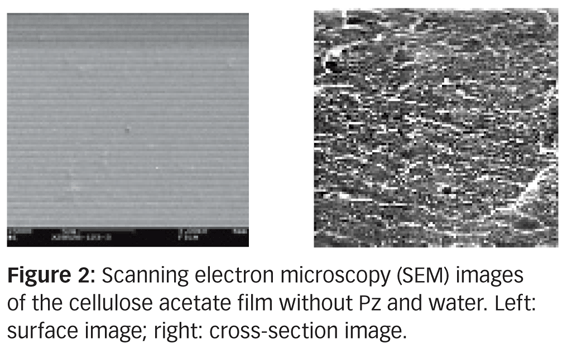
The percentage of elongation reflects the extent to which the films can be stretched, representing the flexibility of a film. Because a plasticizer increases polymer chain mobility, one would expect the Pz level to increase the flexibility of the free films, which increases percent elongation. However, data listed in Tables 46 show that the film was more flexible when no Pz and water existed, and little difference with Pz and water change. This further suggests that PEG 3350 is an ineffective plasticizer for the films in the studied range, and that bigger and more numerous pinholes with increasing Pz and water made the films less stretchable.
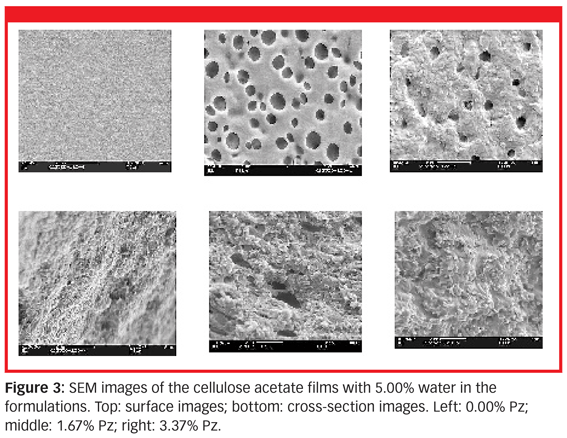
The wettability of a film is represented by the contact angle, with a small angle meaning the film has better wettability. In general, it is known that films plasticized with hydrophilic plasticizer have increased wettability and the films plasticized with hydrophobic plasticizer have decreased wettability. The data in Tables 46 show that the PEG and water level did not affect the wettability of the films in the studied range.
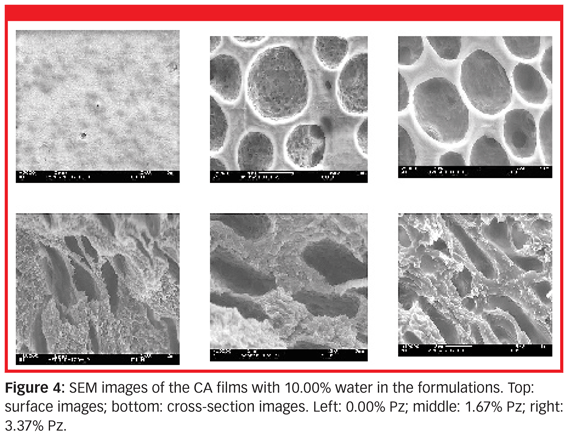
The permeability of a film is a key factor to consider when designing a film formulation. Water vapour transmission rate (WVTR) is a commonly used measurement to determine the permeability of a film. Figure 5 shows the WVTR of CA films changes with Pz and water level. It is not surprising that PEG 3350 alone did not affect WVTR significantly. As previously mentioned, PEG 3350 is not an effective plasticizer for CA in the studied range, but with the interaction of water and PEG 3350, however, WVTR increased with PEG 3350 and water level, and significantly increased when water was more than 5% in the formulations. This result can be explained by the morphologies of the films: scanning electron microsscope images show that the number and size of pinholes increased greatly with water and PEG 3350 level (Figures 24).

Acetyl effects on CA free film properties
CA‑398‑10TG with acetyl content at 40.3% was also used in the film study to determine how a change in acetyl content with a range of approximately 1.0% affects film properties. Comparison of the film properties between CA‑398‑10NF‑EP (NF, 39.4% acetyl) and CA‑398‑10TG (TG, 40.3% acetyl) suggested that no significant acetyl effect on free‑film properties can be observed in the studied range (Tables 46).
Permeability of CA coating on tablets
CA was coated on model tablets prepared, as previously described, and the water uptake was measured as a function of time. The water uptake increased linearly with time because of the nature of the POLYOX resin, which will retain water and swell after absorbing water penetrating through the CA film. When the coating film was no longer able to hold the inside pressure, the film ruptured and the experiment was terminated. The slope of the water uptake curve represents water uptake rate (g/min) and this value changes with formulation factors such as the Pz level and water level.
Design expert software (Design Expert V7; Stat-Ease, Inc., MN, USA) was used to analyse the water uptake data. Based on the data, a model was established to predict water uptake rate. The fitted model is:

in which PEG is the Pz concentration in the formulation as a percentage (0.00–3.37%); Water is the water concentration in the formulation as a percentage (0.00–10.00%); and Acetyl is the percent acetyl content of the CA polymer (39.4–40.3%).
The fitted model indicates that an increase in the Pz level in the formulation increases water uptake rate, which is also true for water level. PEG is the major influencing factor (Figure 6).
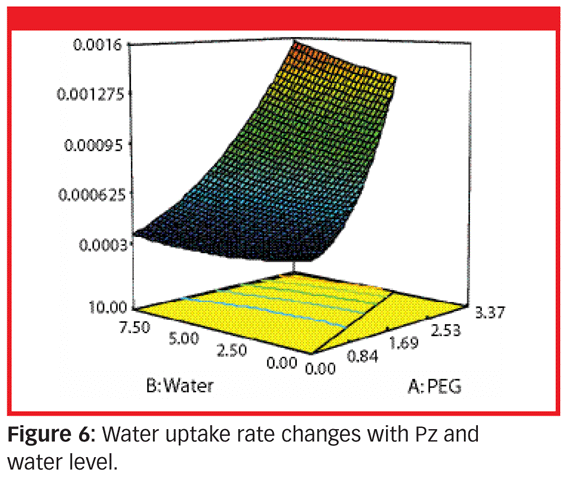
Figure 7 shows water uptake predicted from the model at Pz¡3.00%, Water¡5.00%, Acetyl¡40.3% and Acetyl¡39.4% and the difference in the water uptakes between the CAs with these two acetyl levels is 5.7%.
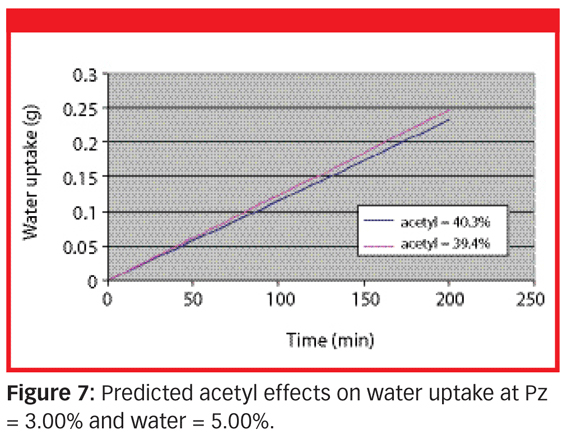
The difference in water uptake by acetyl content is calculated by the following equation:

Acetyl effects on the water uptake decreases significantly with increasing Pz and water in the formulations. Table 7 lists the difference in water uptake by acetyl content, assuming the coating processing conditions are controlled precisely the same.
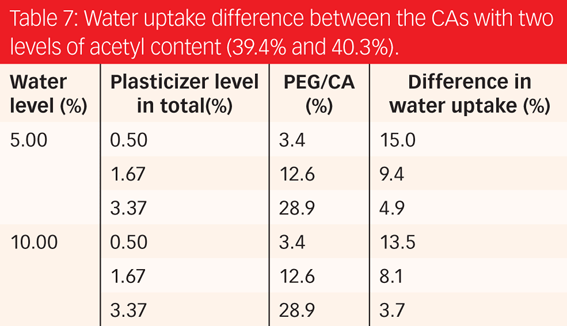
When designing a formulation to eliminate the variations from raw materials, it is, therefore, crucial to understand how formulation factors affect the permeability of the coating film and the release rate of a finished product.
Conclusion
Understanding formulation factor effects on free-film and coating-film properties would provide guidelines for selecting a formulation in the early design stage of developing semipermeable membranes. The results from this study demonstrated that formulation factors such as Pz and water level significantly affect free film properties and coating performance. With increasing Pz level, the mechanical strength of the free films decreased and the permeability of the films increased. With the interaction of Pz and water, the effects on the properties of free films were even greater. Although there were no significant differences in free film properties between CA‑398‑10NF‑EP and CA‑398‑10TG, the permeability of coating films increased with decreasing acetyl content in CA polymers. The acetyl content with a range of approximately 1.0% affected permeability of coating films at some degree and the effects were largely dependent on the formulation. With higher Pz and water levels in the formulation, the acetyl content only slightly affected the permeability of the coating film. This study demonstrates that it is important to design a robust formulation to reduce the variability of a finished product. It should be realized that besides formulation factors, processing conditions are also key controls in ensuring product quality and keeping the release profile of a product in a desirable range.
References
N. Ramakrishna and B. Mishra, Drug Dev. Ind. Pharm., 28(4), 403412 (2002).
G. Deepak and P. Kilambi, Pharm. Technol., 27(9), 5868 (2003).
S.N. Makhija and P.R. Vavia, J. Contr. Release, 89, 518 (2003).
T. Guyonnet, C. Brossard and D. Lefort des Ylouses, J. Pharmacie de Belgiue, 45(2), 111–119 (1990).
O.Y. Abdallah, N.A. Boraie and V.F. Naggar, S.T.P. Pharma, 4(1), 1520 (1988).
M. Corbo et al., World Patent No. 2001080826 (2001).
M.R. Hoy and E.J. Roche, US Patent No. 5489436 (1996).
E.J. Roche, Europe Patent No. 459695 (1991).
R.K. Verma, D.M. Krishna and S. Gard, J. Contr. Release, 79, 727 (2002).
G. Santus and R.W. Baker, J. Contr. Release, 35, 121 (1995).
A.M. Kaushal and S. Garg, Pharm. Technol.,27(8), 3897 (2003).
J. Yuan, P.P. Shang and S.H. Wu, Pharm. Technol., 25(10), 6274 (2001).
M.M. Meier et al., Poly. Adv. Technol., 15(10), 593600 (2004).
M.M. Meier, L.A. Kanis and V. Soldi, Int. J. Pharma.,278, 99110 (2004).
J. Yuan and S.H. Wu, Pharm. Technol.,24(10), 92106 (2000).
J. Yuan and J. Zhu, “Investigation of the Opaqueness in Cellulose Acetate 398-10NF Free Films: Water Effects,” Eastman Technical Report TR-2005-04061 (2005).
Jinghua Yuan
is a Principal Technical Service Representative at Formulation Products Lab, Pharmaceutical Formulations Group, Eastman Chemical Company (TN, USA).
Tel. +1 423 229 8627
Fax + 1 423 224 0414
jinghua@eastman.com
Doug Dunn
is a Senior Laboratory Technician at Formulation Products Lab, Pharmaceutical Formulations Group, Eastman Chemical Company (TN, USA).
Nancy M. Clipse
is a Research Analyst at Formulation Products Lab, Pharmaceutical Formulations Group, Eastman Chemical Company (TN, USA).
Ray J. Newton, Jr.
is a Senior Research Associate at Formulation Products Lab, Pharmaceutical Formulations Group, Eastman Chemical Company (TN, USA).
Drug Solutions Podcast: Applying Appropriate Analytics to Drug Development
March 26th 2024In this episode of the Drug Solutions Podcast, Jan Bekker, Vice President of Business Development, Commercial and Technical Operations at BioCina, discusses the latest analytical tools and their applications in the drug development market.